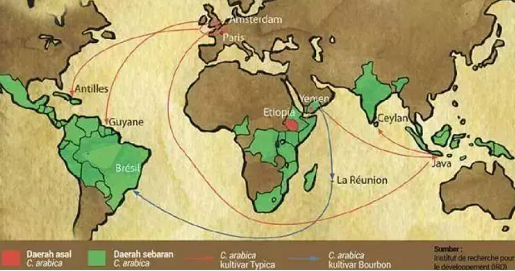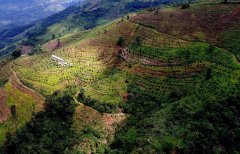The history of coffee beans, the origin of coffee, the spread and development of coffee. How did coffee come from all over the world?
Coffee beans originated in Ethiopia, but the country that pushed coffee to the world was Yemen across the Strait of Mande. this was also because Ethiopia did not attach importance to coffee and had no standardized management at that time, and was amputated by other countries. But fortunately, now the African lion is awakening and is pushing it around the world with lightning.

Coffee crossed the Red Sea and was first transplanted to Yemeni soil in the 17th century. Arabs drink coffee themselves, trade coffee with Europe and try to monopolize the coffee market. It is through these trade channels that coffee is popularized and well known. In the mid-17th century, the Dutch transplanted coffee from Yemen to Java and began to grow coffee there.
From 1500 to 1554, Islamists tried to transplant coffee to Syria and Turkey, but failed because of soil, water and climate.
Around 1600, the Indian Babudan stole seven iron pickup coffee seeds and returned to Karnataka province in southwestern India to breed successfully.
From 1690 to 1696, the Dutch occupied southwestern India and tried to introduce Indian tin cards to Java, Indonesia, but failed. Later, in 1699, the tin card was successfully planted in Indonesia, which became the early coffee growing industry in Asia.
From 1706 to 1710, the Dutch East India Company transported an iron pickup sapling back to Amsterdam, the capital, where it was carefully nursed in a greenhouse. The tree blossomed and bear fruit in 1713.
From 1713 to 1715, the mayor of Amsterdam gave the king of France a sapling of an iron pickup, which the French cultivated and transplanted to South America, and this coffee tree became the source of the Brazilian iron truck.
From 1720 to 1723, Dikrou, a French naval officer, stole the tin card saplings from the botanical garden of Versailles and planted them in French Martinique. Then he gave the successfully cultivated seedlings and seeds to Jamaica, Dominica, Cuba, Guatemala and other Central American countries. Because Arabica coffee trees are self-pollinated, this directly leads to the lack of genetic diversity and sickness of iron pickups in Central America. And the low output is the disadvantage of the iron pickup.
In 1825, Hawaii introduced a modified Guatemalan tin pickup and planted it in Kona kona, today's Kona tin pickup.
In 1892, French missionaries brought the iron pickup to our Yunnan, which became the first coffee in our country-Yunnan iron pickup.

Bourbon:
Bourbon variety coffee beans are the same old varieties as iron pickup and variety coffee beans, which belong to Arabica coffee. Bourbon coffee was originally planted on the Brazilian island of Reunion (Bourbon Island), which was also known as le Bourbon Island before 1789, so the coffee variety was also named "bourbon".
In 1899, French missionaries introduced bourbon coffee seeds from the island of Reunion. These coffee seeds are scattered in the area for the production of coffee beans.
Important Notice :
前街咖啡 FrontStreet Coffee has moved to new addredd:
FrontStreet Coffee Address: 315,Donghua East Road,GuangZhou
Tel:020 38364473
- Prev

What's the difference between individual coffee and espresso? Is a single cup of coffee made by hand?
What is a single product coffee refers to a single product coffee made by coffee beans from a single origin can be traced back to the origin of coffee, tracing back not only to the coffee producing country, but even to the place where the coffee is produced, by knowing the owner of the coffee farm and going deep into the origin of the coffee. understand the story of the origin of coffee from the source and purchase raw beans. What is Italian coffee (Espresso)
- Next

How to plant a coffee tree? The natural conditions of coffee cultivation and the skills of growing coffee.
How to grow coffee well? First of all, geographically, the golden planting belt of coffee is centered on the equator, covering the appropriate temperature from 25 north latitude to 25 south latitude. Coffee likes a warm environment, hardy but not hardy, and the most suitable planting temperature is between 16 degrees Celsius and 21 degrees Celsius. Good land environment, fertile soil. The most suitable soil for growing coffee is in the plains and mountains.
Related
- Detailed explanation of Jadeite planting Land in Panamanian Jadeite Manor introduction to the grading system of Jadeite competitive bidding, Red bid, Green bid and Rose Summer
- Story of Coffee planting in Brenka region of Costa Rica Stonehenge Manor anaerobic heavy honey treatment of flavor mouth
- What's on the barrel of Blue Mountain Coffee beans?
- Can American coffee also pull flowers? How to use hot American style to pull out a good-looking pattern?
- Can you make a cold extract with coffee beans? What is the right proportion for cold-extracted coffee formula?
- Indonesian PWN Gold Mandrine Coffee Origin Features Flavor How to Chong? Mandolin coffee is American.
- A brief introduction to the flavor characteristics of Brazilian yellow bourbon coffee beans
- What is the effect of different water quality on the flavor of cold-extracted coffee? What kind of water is best for brewing coffee?
- Why do you think of Rose Summer whenever you mention Panamanian coffee?
- Introduction to the characteristics of authentic blue mountain coffee bean producing areas? What is the CIB Coffee Authority in Jamaica?

